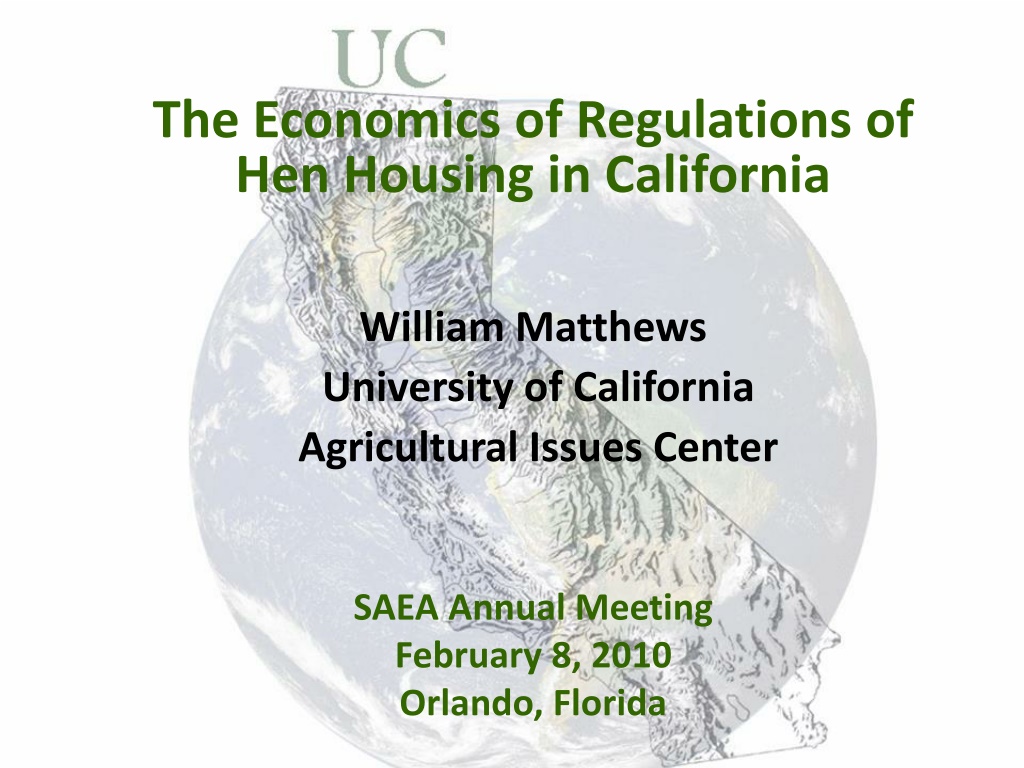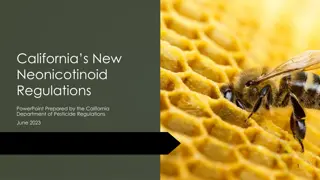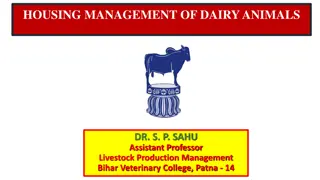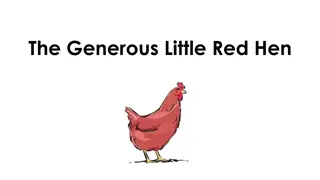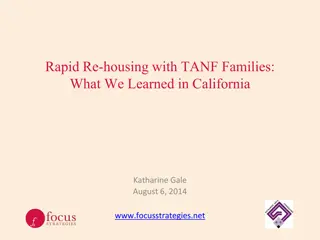The Economics of Regulations on Hen Housing in California
This presentation delves into the economic impact of regulations on hen housing in California, focusing on the California Treatment of Farm Animals Act and its effects on egg production. The Proposition 2 passed in 2008 mandated certain welfare standards for farm animals, including laying hens. The presentation explores the production costs of different hen housing systems and the implications of new regulations on the California shell egg industry. Additionally, it examines the effects of national regulations on the industry.
Download Presentation

Please find below an Image/Link to download the presentation.
The content on the website is provided AS IS for your information and personal use only. It may not be sold, licensed, or shared on other websites without obtaining consent from the author. Download presentation by click this link. If you encounter any issues during the download, it is possible that the publisher has removed the file from their server.
E N D
Presentation Transcript
The Economics of Regulations of Hen Housing in California William Matthews University of California Agricultural Issues Center SAEA Annual Meeting February 8, 2010 Orlando, Florida
The Economics of Regulations on Hen Housing in California Prepared for Presentation at the 2010 annual meeting of the Southern Agricultural Economics Association Daniel A. Sumner, William A. Matthews, Joy A. Mench and J. Thomas Rosen-Molina Daniel A. Sumner is the Frank H. Buck, Jr. Professor in the Department of Agricultural and Resource Economics, University of California, Davis and Director of the University of California Agricultural Issues Center William A. Matthews is post-doctoral scholar with AIC. Thomas Rosen Molina is a research associate with AIC. Joy Mench is a professor in the Department of Animal Science at UC Davis.
Outline of Presentation California Treatment of Farm Animals Act Egg production and consumption in California Production costs of different hen housing systems Effects of new regulations on California shell egg industry. Effects of national regulations.
California Treatment of Farm Animals Act (TFAA) November 2008 general election. California Proposition #2 Shall certain farm animals be allowed, for the majority of every day, to fully extend their limbs or wings, lie down, stand up and turn around? Passed 63.5% Yes 36.5% No Date of Enforcement: January 1, 2015
Administration of TFAA Regulations (California Health and Safety Code Section 25990-25994) a person shall not tether or confine any covered animal, on a farm, for all or the majority of any day, in a manner that prevents such animal from: (a) Lying down, standing up, and fully extending his or her limbs; and (b) Turning around freely. For laying hens in California "Fully extending his or her limbs" means fully extending all limbs without touching the side of an enclosure, including, in the case of egg-laying hens, fully spreading both wings without touching the side of an enclosure or other egg-laying hens. Turning around freely" means turning in a complete circle without any impediment, including a tether, and without touching the side of an enclosure.
California Laying Hen Population and Egg Production, 1963-2008 45 10 9 40 8 35 7 Number of Eggs Produced (billions) Population of Laying Hen (millions) 30 6 5 25 4 20 California Laying Hen Population California Egg Production 3 15 2 10 1 1963 1967 1971 1975 1979 1983 1987 1991 1995 1999 2003 2007 Year Source: USDA NASS Chicken and Eggs Annual Summary. Note: Egg production includes hatching and liquid eggs, estimated to be about 2 percent and 5 to 8 percent of total output, respectively (Don Bell, personal communication).
Average annual number of laying hens and eggs produced in California and the United States, 1997-2007 California United States Average number of laying hens on hand1 Average number of Laying hens on hand1 Eggs1 Eggs1 Year Thousands 25,161 25,526 24,163 23,757 24,165 20,831 20,222 19,336 19,313 20,610 20,272 Millions 6,608 6,606 6,319 6,082 6,257 5,439 5,352 5,082 4,962 5,290 5,272 Thousands 255,832 264,790 270,903 277,964 280,023 279,174 283,671 284,888 289,415 281,211 276,075 Millions 67,545 70,240 71,748 73,299 74,324 74,683 76,384 76,859 78,276 77,659 76,811 1998 1999 2000 2001 2002 2003 2004 2005 2006 2007 2008 1 Includes hens and eggs for hatching purposes. Current estimates put hens and eggs for hatching at 2% of California egg production.
Top 10 Egg Producing States by Number of Laying Hens 2008 Average number of table-egg laying hens1 2008 Share of U.S. table-egg laying hens1 (percent) State Thousands 2008 52,588 25,779 23,407 20,400 19,964 13,883 9,961 9,681 9,555 9,300 81,558 276,075 Iowa Ohio Indiana Pennsylvania California Texas Florida Nebraska Minnesota Georgia Other States U.S. Total 19 9 8 7 7 5 4 4 3 3 30 100 1 Includes only hens for table-egg production. Sources: USDA NASS 2008 Chicken and Eggs Summary
Estimated Shell Eggs Consumed in California, 2000-2007 8500 7500 6500 Million Shell Eggs Consumed 5500 4500 Shell Eggs Produced in CA Shell Eggs Shipped to CA Total Shell Eggs in CA 3500 2500 1500 500 2000 2001 2002 2003 2004 2005 2006 2007 Year Sources: Shell egg consumption comes from USDA NASS data and CDFA data compiled by Don Bell in "Annual Egg Industry Statistics." Note: Total shell egg consumption is the sum of shell eggs produced in California plus total out of state shipments of shell eggs into California. Shell eggs are those table eggs marketed in the shell. Breakers are those table eggs marketed in liquid form most often to the food processing or food service industries. There are no spearate data on shell eggs in California, but based on industry sources and Table III.2 we estimate that, currently, about 95 percent of California table eggs and about 93 percent of all California eggs are marketed as shell eggs. The data in this figure have been adjusted accordingly.
Comparison of Production Costs Between Cage Production System and Non-cage Production System in Cost per Dozen Non-Cage production system range and median Cost Differential Non-Cage minus Cage System using mid-points ($ per dozen) Cost differential Non-Cage minus Cage System using low costs Cage production system range and median 0.09 - 0.11 0.10 0.14 - 0.17 0.155 Pullets1 0.055 0.05 0.28 - 0.45 0.365 0.35 - 0.50 0.425 Feed 0.06 0.07 0.05 - 0.14 0.095 0.09 - 0.37 0.23 Housing2 0.135 0.04 0.03 0.04 0.035 0.07 0.19 0.13 Labor3 0.095 0.04
Non-Cage production system range and median Cost Differential Non-Cage minus Cage System using mid-points ($ per dozen) Cost differential Non-Cage minus Cage System using low costs Cage production system range and median Sum of the itemized costs and difference at the mid-points 0.595 0.94 0.345 Sum of the itemized costs and differences at the low costs Percentage cost difference based on the sum of items 0.45 0.65 0.20 0.345/0.595= 58% 0.20/0.45= 44% 0.57 - 0.92 0.745 0.97 1.13 1.05 Total Cost4 0.305 0.40 Percentage cost difference 0.305/0.745 = 41% 0.40/0.57 = 70%
Market Effects of Layer Hen Housing Restrictions in California in the National Market for Eggs Price, marginal cost Demand U.S. New marginal cost/supply, CA Marginal cost/supply, CA Price Q, U.S. Initial Q, CA Q, eggs in the U.S.
Market Effects of Layer Hen Housing Restrictions in California in the California Market for Eggs Price, marginal cost New marginal cost/supply, CA producers Pshell eggs CA 2 Pshell eggs CA 1 Price, shell eggs Marginal cost, CA producers Demand shell eggs in CA Shipped into CA Initial Q, CA producers Q shell eggs consumed, CA
Market Effects of Layer Hen Housing Restrictions in California in the Market for California-produced Eggs Price, marginal cost New marginal cost/supply, CA producers Price, CA shell eggs Demand, CA produced shell eggs Marginal cost, CA producers Initial Q, California-produced shell eggs
A Bit of Log Linear Algebra (1) dlnQd= (dlnP - dlnB) (2) dlnQs= (dlnP - dlnC) (3) dlnQd = dlnQs = dlnQ (4) dlnP dlnB = dlnP dlnC (5) dlnP = [- /( - )](dlnC) + [ /( - )]dlnB) (6) dlnQ = [- /( - )](dlnC dlnB)
Qd - quantity of eggs demanded Qs - quantity of eggs supplied P - price of eggs - price elasticity of demand facing egg producers - elasticity of supply B - additional willingness to pay for eggs produced using a non-cage housing system. C - additional cost of producing eggs using a non-cage system
Price and Quantity effects of a 20% cost increase with different elasticities and willingness to pay for eggs, California Demand elasticity facing CA producers = -20 Supply elasticity =5 Supply elasticity =10 Willingness to pay shift dlnB (percent) Cost shift dlnC (percent) Quantity effect (percent) Quantity effect (percent) Price effect (percent) Price effect (percent) 0 4.00 -80.00 6.67 eliminate 20 5 8.00 -60.00 10.00 eliminate 10 12.00 -40.00 13.33 eliminate
Price and Quantity effects of a 30% cost increase with different elasticities and willingness to pay for eggs, California Demand elasticity facing CA producers = -20 Supply elasticity =5 Supply elasticity =10 Willingness to pay shift dlnB (percent) Cost shift dlnC (percent) Quantity effect (percent) Quantity effect (percent) Price effect (percent) Price effect (percent) 0 6.00 eliminate 10.00 eliminate 30 5 10.00 eliminate 13.33 eliminate 10 14.00 -80.00 16.67 eliminate
Price and Quantity effects of a 40% cost increase with different elasticities and willingness to pay for eggs, California Demand elasticity facing CA producers = -20 Supply elasticity =5 Supply elasticity =10 Willingness to pay shift dlnB (percent) Cost shift dlnC (percent) Quantity effect (percent) Quantity effect (percent) Price effect (percent) Price effect (percent) 0 8.00 eliminate 13.33 eliminate 40 5 12.00 eliminate 16.67 eliminate 10 16.00 eliminate 20.00 eliminate
Price and Quantity effects of a 20% cost increase with different elasticities and willingness to pay for eggs, United States Demand elasticity = -0.1 Demand elasticity =-0.2 Supply elasticity =5 Supply elasticity =10 Supply elasticity =5 Supply elasticity =10 Willingness to pay shift dlnB (percent) Quantity effect (percent) Quantity effect (percent) Cost shift dlnC (percent) Quantity effect (percent) Quantity effect (percent) Price effect (percent) Price effect (percent) Price effect (percent) Price effect (percent) 0 19.96 -1.96 19.80 -1.98 19.23 -3.85 19.61 -3.92 20 5 19.97 -1.47 19.85 -1.49 19.42 -2.88 19.71 -2.94 10 19.98 -0.98 19.90 -0.99 19.62 -1.92 19.80 -1.96
Price and Quantity effects of a 30% cost increase with different elasticities and willingness to pay for eggs, United States Demand elasticity = -0.1 Demand elasticity =-0.2 Supply elasticity =5 Supply elasticity =10 Supply elasticity =5 Supply elasticity =10 Willingness to pay shift dlnB (percent) Quantity effect (percent) Quantity effect (percent) Cost shift dlnC (percent) Quantity effect (percent) Quantity effect (percent) Price effect (percent) Price effect (percent) Price effect (percent) Price effect (percent) 0 29.41 -2.94 29.70 -2.97 28.85 -5.77 29.41 -5.88 30 5 29.51 -2.45 29.75 -2.48 29.04 -4.81 29.51 -4.90 10 29.61 -1.96 29.80 -1.98 29.23 -3.85 29.61 -3.92
Price and Quantity effects of a 40% cost increase with different elasticities and willingness to pay for eggs, United States Demand elasticity = -0.1 Demand elasticity =-0.2 Supply elasticity =5 Supply elasticity =10 Supply elasticity =5 Supply elasticity =10 Willingness to pay shift dlnB (percent) Quantity effect (percent) Quantity effect (percent) Cost shift dlnC (percent) Quantity effect (percent) Quantity effect (percent) Price effect (percent) Price effect (percent) Price effect (percent) Price effect (percent) 0 39.22 -3.92 39.60 -3.96 38.46 -7.69 39.22 -7.84 40 5 39.31 -3.43 39.65 -3.47 38.65 -6.73 39.31 -6.86 10 39.41 -2.94 39.70 -2.97 38.85 -5.77 39.41 -5.88
Results of TFAA on California Egg Industry Majority of egg production will leave California January 10, 2010 Wall Street Journal (Lauren Etter ) A year after Californians approved stricter rules on the treatment of farm animals, Idaho and other states are trying to lure away the Golden State's poultry and egg farmers with promises of friendlier regulations and lower costs. In Idaho, where there's currently little poultry production, Doug Manning, economic-development director of the town of Burley, said he wanted to offer incentives to poultry farmers as a way to increase jobs and tax revenue in the area. He has heard from a few California farmers who "are looking at some options," Mr. Manning said. "We said, 'When you're ready, give us a chance.' "
